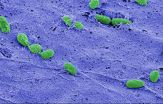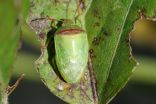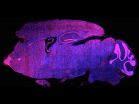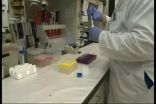(Press-News.org) Bacteria are best known as free-living single cells, but in reality their lives are much more complex. To survive in harsh environments, many species of bacteria will band together and form a biofilm--a collection of cells held together by a tough web of fibers that offers protection from all manner of threats, including antibiotics. A familiar biofilm is the dental plaque that forms on teeth between brushings, but biofilms can form almost anywhere given the right conditions.
Biofilms are a huge problem in the health care industry. When disease-causing bacteria establish a biofilm on sensitive equipment, it can be impossible to sterilize the devices, raising rates of infection and necessitating expensive replacements. So researchers look for ways to break down the defenses of biofilms to prevent them from establishing a foothold.
Now, a University of Maryland-led team has found an important link in the biofilm formation process: an enzyme that shuts down the signals that bacteria use to form a biofilm. The findings, reported in the August 24, 2015 Early Online Edition of the Proceedings of the National Academy of Sciences, have far-reaching implications for the development of new treatments, and could one day help make biofilm-related complications a distant memory.
"Bacteria form biofilms because they sense a change in their environment. They do this by generating a signaling molecule, which binds to a receptor that turns on the response," said Mona Orr, the lead author of the study and a UMD biological sciences graduate student. "But you need a way to turn off the switch--to remove the signal when it's no longer needed. We've identified the enzyme that completes the process of turning off the switch."
The well-known switch that activates biofilm formation is a signaling molecule called Cyclic-di-GMP, also known as c-di-GMP. Many species of disease-causing bacteria use c-di-GMP to signal the formation of biofilms, including Escherichia coli, Salmonella enterica and Vibrio cholerae.
But Orr and her colleagues are the first to identify the molecule that completes the process of clearing c-di-GMP from the cell, thus ending the biofilm signaling process. The molecule is an enzyme called oligoribonuclease, and much like c-di-GMP, oligoribonuclease is also common among disease-causing bacterial species.
The team studied the process in the bacteria Pseudomonas aeruginosa, a common species known to cause infections in hospital patients. But because of the genetic and physiological similarities between P. aeruginosa and other infectious species, the researchers believe that oligoribonuclease serves the same function across a wide variety of bacteria.
"You can think of this process in terms of water filling a sink. The rate of water from the faucet is just as important as the size of the drain in determining the level of water in the sink," said Vincent Lee, a co-author of the study and an associate professor in the UMD Department of Cell Biology and Molecular Genetics and the Maryland Pathogen Research Institute. "The level of c-di-GMP in the cell is analogous to the amount of water in the sink. Because no one knew what the drain was, our findings create a complete picture of the signaling process."
Orr, Lee and their colleagues from the UMD Department of Chemistry and Biochemistry and Michigan State University focused their work on P. aeruginosa because it is well studied and can survive under a variety of conditions, making it notoriously difficult to control. Contact lens wearers might already be familiar with P. aeruginosa, as it commonly forms infectious, green-tinted biofilms on older lenses or those that have not been cleaned properly.
The team found that oligoribonuclease is necessary for the second of a two-step process. The first, which converts c-di-GMP into an intermediate molecule called pGpG, was already known. Orr, Lee and their colleagues have now filled in the important second step in this process: oligoribonuclease breaks apart pGpG and thus completely shuts off the signaling pathway.
The result suggests that oligoribonuclease could be used to help design new antibiotics, disinfectants, and surface treatments to control biofilms. Such measures could prevent infections and preclude the need for frequent replacement of expensive hospital equipment. Because biofilms can also form on implanted medical devices, such as pacemakers and synthetic joints, effective treatments against biofilms could eliminate the need for costly and risky replacement surgeries.
While oligoribonuclease most likely shuts down biofilm formation in many infectious bacterial species, Orr and Lee acknowledge that their discovery is not quite a "silver bullet" that can fight every type of biofilm.
"The genes that make these signals are found in most bacteria. The oligoribonuclease enzyme that breaks the effect is only found in some, however," Lee explained. "So there must be parallels in the organisms that don't have oligoribonuclease. Finding these other 'off' switches is high on our list of future research goals."
INFORMATION:
In addition to Orr and Lee, UMD authors on the paper include Herman Sintim, associate professor in the UMD Department of Chemistry and Biochemistry, Jingxin Wang (Ph.D. '11, chemistry) and Gregory Donaldson (B.S. '10, biological sciences).
This work was funded by the National Institutes of Health's National Institute of Allergy and Infectious Diseases (Award Nos. T32-AI089621 and R21AI096083) and the National Science Foundation (Award Nos. MCB1253684 and CHE0746446). The content of this article does not necessarily reflect the views of these organizations.
The research paper, "Oligoribonuclease is the primary degradative enzyme for pGpG in Pseudomonas aeruginosa that is required for cyclic-di-GMP turnover," Mona Orr, Gregory Donaldson, Geoffrey Severin, Jingxin Wang, Herman Sintim, Christopher Waters, and Vincent Lee, was published August 24, 2015 in the Early Online Edition of the Proceedings of the National Academy of Sciences.
Media Relations Contact: Matthew Wright, 301-405-9267, mewright@umd.edu
University of Maryland
College of Computer, Mathematical, and Natural Sciences
2300 Symons Hall
College Park, MD 20742
http://www.cmns.umd.edu
@UMDscience
About the College of Computer, Mathematical, and Natural Sciences
The College of Computer, Mathematical, and Natural Sciences at the University of Maryland educates more than 7,000 future scientific leaders in its undergraduate and graduate programs each year. The college's 10 departments and more than a dozen interdisciplinary research centers foster scientific discovery with annual sponsored research funding exceeding $150 million.
Atlanta, GA - August 24, 2015 - Respiratory syncytial virus (RSV), which is the leading cause of childhood respiratory hospitalizations among premature babies, can be detected from the clothes worn by caregivers/visitors who are visiting infants in the neonatal intensive care unit (NICU), according to research being presented at the International Conference on Emerging and Infectious Diseases in Atlanta, Georgia.
"The aim of this study was to identify potential sources of transmission of RSV in the NICU to better inform infection control strategies," said Dr. Nusrat ...
Atlanta, GA - August 24, 2015 - Experts show that while Middle East Respiratory Syndrome (MERS-CoV), a viral respiratory illness, is infecting less people, it has a higher mortality rate and affects a specific target population when compared to Severe Acute Respiratory Syndrome (SARS-CoV). This research is being presented at the International Conference on Emerging and Infectious Diseases in Atlanta, Georgia.
"The research conducted in this study focuses on understanding what population of individuals are most likely to become infected by MERS-CoV, compared to the population ...
BEAUMONT -- Entomologists in Texas got a whiff of a new stink bug doing economic damage to soybeans in Texas and are developing ways to help farmers combat it, according to a report in the journal Environmental Entomology.
Various types of stink bugs have long been a problem on soybean crops, but when sweeps of fields in southeast Texas netted 65 percent redbanded stink bugs, entomologists realized this particular bug had become the predominant pest problem, according to Dr. Mo Way, an entomologist at the Texas A&M AgriLife Research and Extension Center in Beaumont.
The ...
Philadelphia, PA, August 24, 2015 - Antibiotic-resistant bacteria are a concern for the health and well-being of both humans and farm animals. One of the most common and costly diseases faced by the dairy industry is bovine mastitis, a potentially fatal bacterial inflammation of the mammary gland (IMI). Widespread use of antibiotics to treat the disease is often blamed for generating antibiotic-resistant bacteria. However, researchers investigating staphylococcal populations responsible for causing mastitis in dairy cows in South Africa found that humans carried more antibiotic-resistant ...
Cancer researchers are constantly in search of more-effective and less-toxic approaches to stopping the disease, and have recently launched clinical trials testing a new class of drugs called BET inhibitors. These therapies act on a group of proteins that help regulate the expression of many genes, some of which play a role in cancer.
New findings from The Rockefeller University suggest that the original version of BET inhibitors causes molecular changes in mouse neurons, and can lead to memory loss in mice that receive it. Published in Nature Neuroscience on August ...
Resveratrol, a compound found commonly in grape skins and red wine, has been shown to have several potentially beneficial effects on health, including cardiovascular health, stroke prevention and cancer treatments. However, scientists do not yet fully understand how the chemical works and whether or not it can be used for treatment of diseases in humans and animals.
Now, researchers at the University of Missouri have found that resveratrol does affect the immune systems of dogs in different ways when introduced to dogs' blood. Sandra Axiak-Bechtel, an assistant professor ...
In a new effort, researchers from the University of Pennsylvania and Baylor College of Medicine have used advanced imaging technology to fill in details about the underlying cause of canine diabetes, which until now has been little understood. For the first time, they've precisely quantified the dramatic loss of insulin-producing beta cells in dogs with the disease and compared it to the loss observed in people with type I diabetes.
"The architecture of the canine pancreas has never been studied in the detail that we have done in this paper," said Rebecka Hess, professor ...
Black bears in Yosemite National Park that don't seek out human foods subsist primarily on plants and nuts, according to a study conducted by biologists at UC San Diego who also found that ants and other sources of animal protein, such as mule deer, make up only a small fraction of the bears' annual diet.
Their study, published in this week's early online edition of the journal Methods in Ecology and Evolution, might surprise bear ecologists and conservationists who had long assumed that black bears in the Sierra Nevada rely on lots of protein from ants and other insects ...
For pregnant women who are at low risk of complications giving birth, the risk of newborn death and maternal complications is similar for obstetric deliveries by family physicians and obstetricians, according to a large study published in CMAJ (Canadian Medical Association Journal).
"It is common to assume that more specialized or higher-volume medical care will result in improved outcomes," writes Dr. Kris Aubrey-Bassler with the Primary Healthcare Research Unit, Discipline of Family Medicine, Memorial University of Newfoundland, St. John's, Newfoundland. "The obstetric ...
A new Canadian guideline aims to ensure that pain during vaccination is minimized in both children and adults. The guideline, published in CMAJ (Canadian Medical Association Journal), is targeted at all health care providers who administer vaccines.
"Pain from vaccinations is common and can make people hesitate about getting future vaccines even as adults," states Dr. Anna Taddio, Senior Associate Scientist at The Hospital for Sick Children (SickKids), Toronto, Ontario, and Leslie Dan Faculty of Pharmacy, University of Toronto. "This can put people at risk of contracting ...



